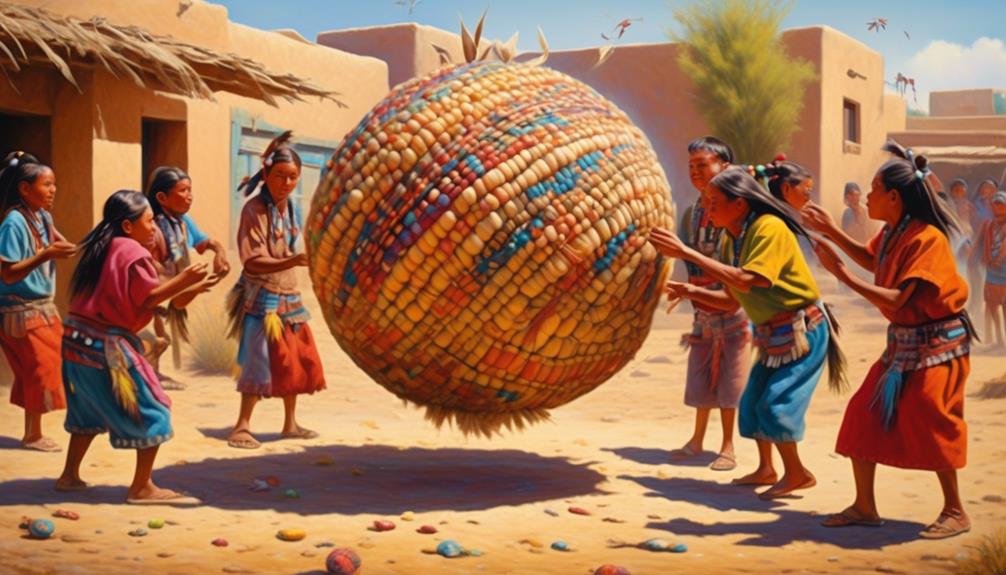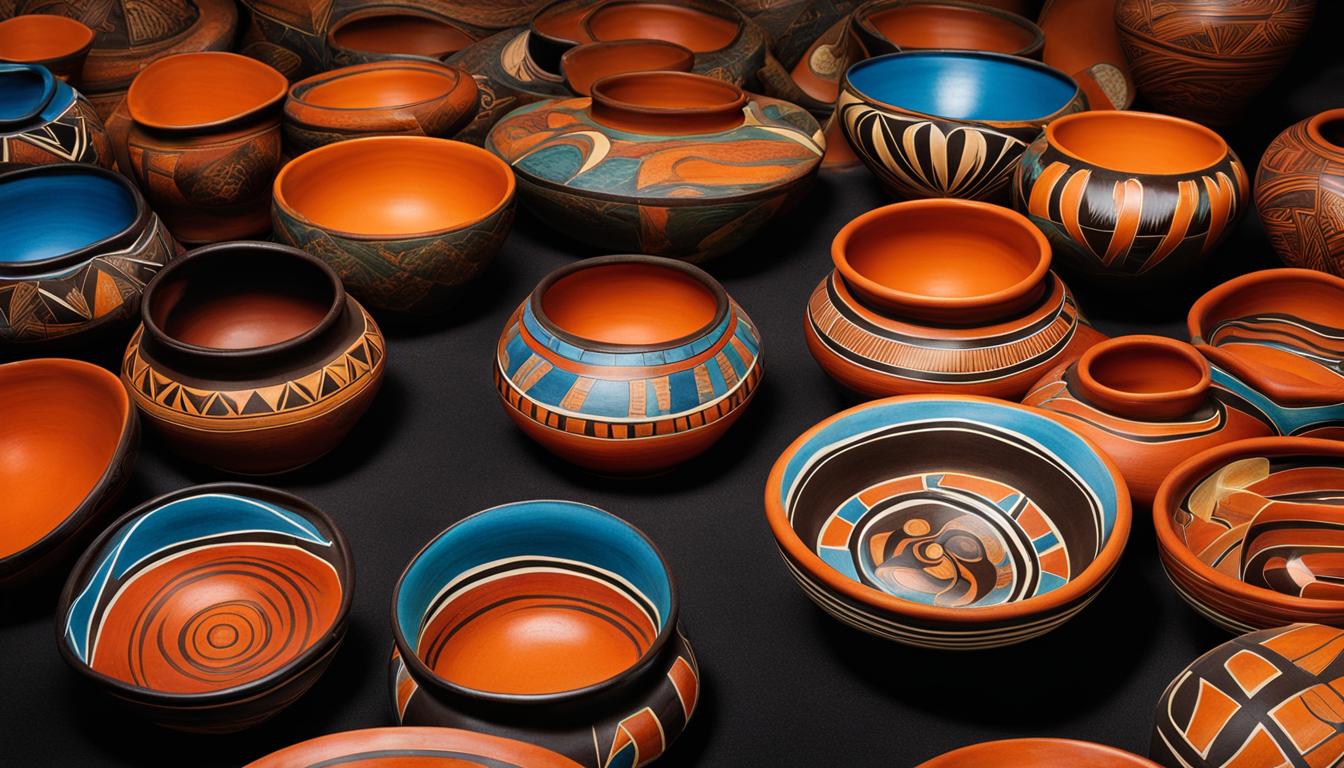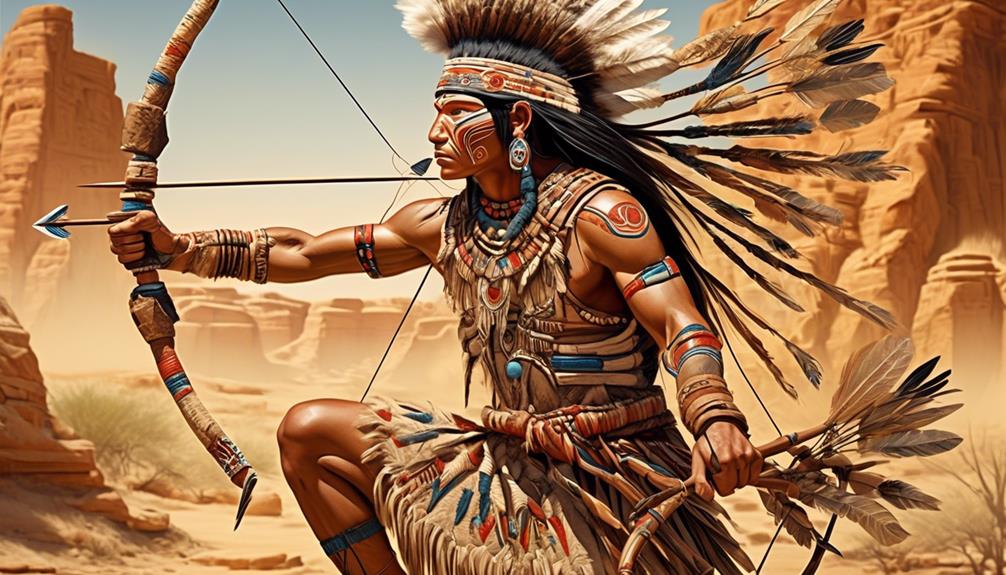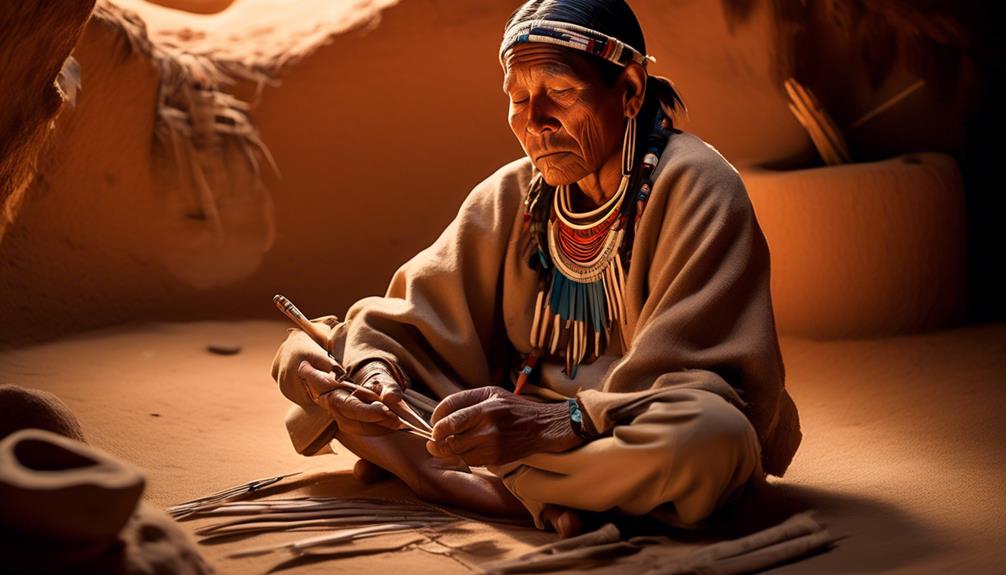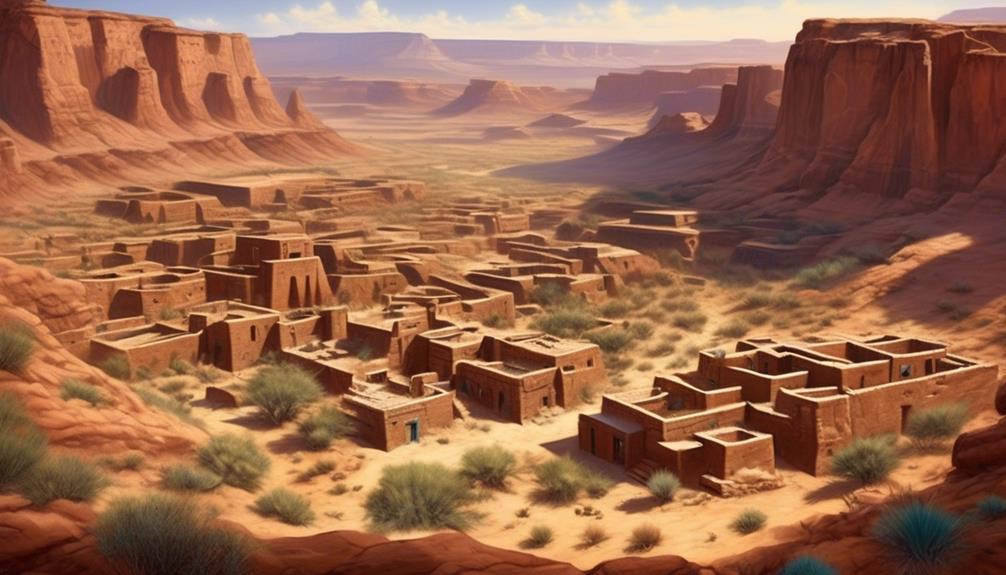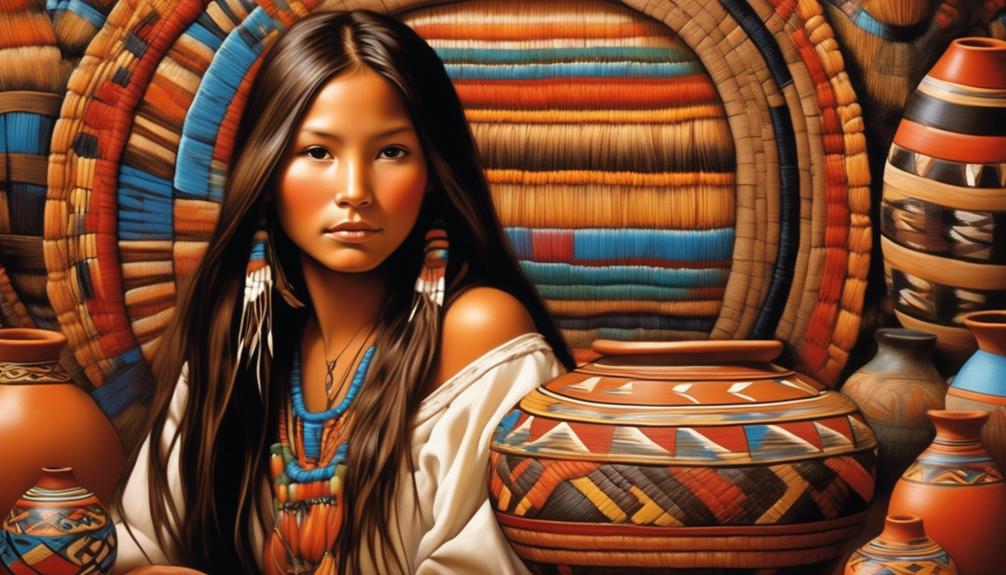As we delve into the rich culture of the Hopi people, it becomes clear that games hold a deeper meaning beyond mere entertainment – they serve as a meaningful expression of the tribe’s beliefs, traditions, and community connections.
But what exactly were these games, and what insights do they offer into the Hopi way of life?
Let's explore the traditional games played by the Hopi tribe and unravel the significance they held within their society, shedding light on the role of play in shaping their cultural identity and transmitting essential skills and knowledge through generations.
Key Takeaways
- Hopi games such as hopscotch, footraces, hoop dancing, and hand games play a crucial role in preserving and perpetuating Hopi cultural heritage.
- These games reinforce the Hopi connection to their land, ancestors, and the spiritual world, fostering community bonding and unity.
- Through games, essential cultural practices and teachings are transmitted, and a sense of continuity and identity is created within the Hopi community.
- Hopi games impart skills such as strategic thinking, problem-solving, physical agility, teamwork, communication, and collaboration while reinforcing cultural values and traditions.
Traditional Hopi Games
Traditional Hopi games have been passed down through generations and continue to be a source of community bonding and cultural preservation. Hopscotch, footraces, hoop dancing, hand games, and storytelling are integral parts of traditional Hopi games. These activities not only provide physical activity but also serve as a means for social interaction and cultural preservation.
Hopscotch, known as 'patok'ova' in the Hopi language, is a game where players hop around a series of squares drawn on the ground, testing their agility and balance. Footraces are another popular game, promoting physical fitness and friendly competition within the community. Hoop dancing, a mesmerizing display of skill and grace, is both a game and a form of storytelling, as dancers depict various aspects of Hopi life through intricate movements.
Hand games, often accompanied by traditional songs, are a way for individuals to showcase their dexterity and strategy while engaging in social interaction. Additionally, storytelling is woven into many of these games, passing down cultural knowledge and traditions from one generation to the next. These games not only provide entertainment but also serve as a means for cultural preservation, strengthening the bonds within the Hopi community.
Role of Games in Hopi Culture
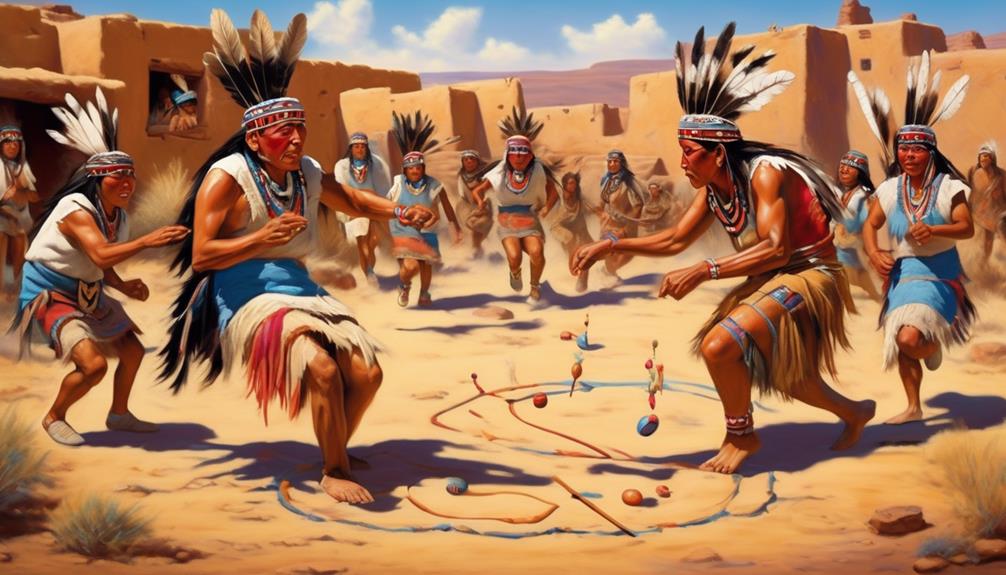
Games play a pivotal role in preserving and perpetuating the cultural heritage of the Hopi tribe, fostering community cohesion, and passing down ancestral knowledge through engaging and interactive activities.
The cultural significance of games within the Hopi tribe can't be overstated. These traditional games are deeply intertwined with the tribe's belief systems, values, and social structure, serving as a means of transmitting essential cultural practices and teachings from one generation to the next. Through games, the Hopi people reinforce their connection to the land, their ancestors, and the spiritual world, creating a sense of continuity and identity within their community.
Furthermore, games serve as a platform for community bonding, bringing people together in shared experiences that strengthen interpersonal relationships and promote unity. Whether it's the competitive spirit of games or the collaborative effort required to play, these activities facilitate social interaction and cooperation among individuals of all ages. As a result, games contribute to the overall cohesiveness of the Hopi tribe, fostering a sense of belonging and mutual support within the community.
Ultimately, the role of games in Hopi culture extends far beyond mere entertainment, serving as a cornerstone for cultural preservation and community solidarity.
Skills and Values Taught Through Games
In our cultural tradition, the games we engage in impart crucial skills and values that are essential for our community's development and well-being.
Through our games, we instill important skills such as strategic thinking, problem-solving, and physical agility. These skills aren't only valuable in the context of the games themselves, but they also translate into practical abilities that are essential for success in our daily lives.
Additionally, our games emphasize the significance of teamwork and cooperation. Players learn to communicate effectively, collaborate, and support each other, fostering a strong sense of community and shared purpose.
Furthermore, our games are deeply intertwined with our traditions and cultural values, serving as a means of passing down important knowledge and wisdom from one generation to the next. As we engage in these games, we aren't only honing our skills but also reinforcing the values that are fundamental to our way of life.
This connection between games, skills, traditions, and cultural values underscores the holistic nature of our approach to play, where every game carries significance beyond mere entertainment, enriching and sustaining our community.
Importance of Games in Hopi Society

Embedded within the fabric of our society, games serve as a conduit for transmitting cultural knowledge and fostering essential skills and values. The importance of games in Hopi society can't be overstated, as they hold significant cultural significance and play a crucial role in community bonding.
- Preservation of Tradition: Games are a means through which the Hopi people pass down their traditions, stories, and values from one generation to the next. Through the act of playing, younger members of the community absorb the cultural knowledge embedded within these traditional games, ensuring the preservation of their heritage.
- Fostering Community Bonding: Games bring members of the community together, promoting a sense of unity and cooperation. Whether it's through competitive games or collaborative activities, the shared experience of playing games fosters a strong sense of community bonding among the Hopi people.
- Development of Essential Skills: Traditional Hopi games are designed to teach important skills such as agility, strategic thinking, and teamwork. These skills are essential for the survival and prosperity of the community, making games a vital aspect of the societal framework.
Modern Influence on Hopi Games
With the ongoing evolution of societal dynamics, the traditional role of Hopi games within the community has encountered an increasing influence from modern perspectives and practices. As the world continues to modernize, the Hopi Tribe has faced the challenge of balancing the preservation of their cultural heritage with the adaptation of their traditional games to fit within contemporary society.
Influence from modernization has prompted the Hopi Tribe to adapt their games to appeal to younger generations while still maintaining their cultural significance. This adaptation has led to the incorporation of modern materials and equipment into traditional games, such as using rubber balls instead of handmade ones. Additionally, modern influences have also led to the creation of new games that blend traditional elements with contemporary concepts, ensuring that the cultural significance of the games remains intact while appealing to a broader audience.
The modern influence on Hopi games has sparked a careful balance between cultural preservation and adaptation. While the essence of the games remains rooted in tradition, the incorporation of modern elements has allowed these games to continue thriving in today's world.
Frequently Asked Questions
How Do the Hopi Games Differ From Games Played by Other Native American Tribes?
The Hopi games differ from those of other Native American tribes in various ways. Differences in rules, equipment, social significance, and cultural significance are evident.
The distinct rules and equipment used in Hopi games set them apart. Additionally, the social and cultural significance of these games varies from those of other tribes.
Understanding these differences provides insight into the unique traditions and values of the Hopi tribe.
Are There Any Specific Rituals or Ceremonies Associated With Playing Traditional Hopi Games?
Playing traditional Hopi games is more than just recreation; it's woven into our cultural tapestry. These games play a significant role in our ceremonies, symbolizing important aspects of our beliefs and values. Through these activities, we bond as a community, strengthening our social fabric.
The cultural significance of these games is profound, as they connect us to our heritage and ancestors. Their role in our rituals is a testament to their enduring importance.
Do Hopi Children Have a Favorite Game They Enjoy Playing the Most?
As Hopi children, we've always cherished our traditional play. Our favorite games are deeply rooted in our culture and hold significant value. These outdoor activities connect us to our heritage and community, fostering a sense of pride and belonging.
Through these games, we learn important skills and values, passing down our customs to future generations. Our favorite games not only bring us joy but also preserve our cultural identity.
What Materials Are Typically Used to Create the Equipment Needed for Traditional Hopi Games?
When it comes to traditional games of the Hopi Tribe, various materials are used to create the equipment needed. These materials often include natural resources like wood, feathers, clay, and plant fibers. The equipment for traditional Hopi games is meticulously crafted to ensure authenticity and durability.
Understanding the significance of these materials in the context of traditional games provides valuable insights into the cultural and historical practices of the Hopi Tribe.
Have Any Modern Adaptations of Traditional Hopi Games Been Created for Entertainment or Educational Purposes?
Absolutely, modern adaptations of traditional Hopi games have been created for both entertainment and educational purposes. These adaptations play a crucial role in cultural preservation and the promotion of indigenous gaming.
By integrating these games into modern settings, we maintain their relevance and significance while also making them accessible to a wider audience.
This approach not only ensures the survival of these traditional games but also promotes a deeper understanding of Hopi culture and history.
Conclusion
In conclusion, the traditional games of the Hopi tribe were like seeds carefully planted in the fertile soil of their culture, nurturing important skills and values.
These games served as pillars of their society, holding up the teachings and traditions of their ancestors.
As modern influences have touched their games, it's important for the Hopi people to continue to protect and preserve the roots of their traditional games, ensuring that they continue to grow strong and vibrant for generations to come.
Mary is a passionate writer who brings creativity and a fresh perspective to our team. Her words have the power to captivate and inspire, making her an essential contributor to our content. Mary’s commitment to storytelling and dedication to promoting Indigenous culture ensures that her work touches the hearts of our readers. We’re fortunate to have her as part of our team.
